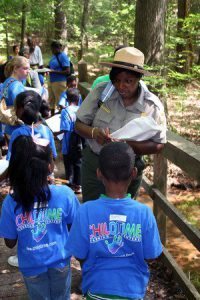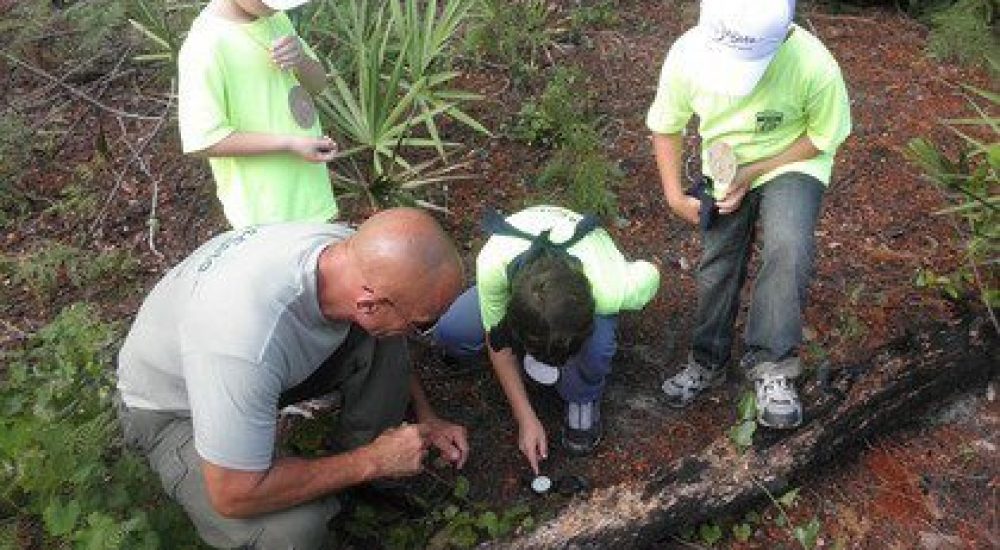Asia Society and BOOST Collaborative are partnering to create a series of blogs on global learning in out-of-school time. This blog entry was originally published on EdWeek’s Global Learning Blog. This piece is written by Linda Rosenblum, Education Program Manager and Servicewide Teacher Ranger Teacher Coordinator, National Park Service.
National Park Service (NPS) parks and historic sites provide unique opportunities for students to study history, science, civics, culture, and global issues by providing access to primary historical resources, scientific data, subject matter experts and professionals, and community connections to local cultural heritage. As the National Park Service celebrates its 100th birthday, increased attention has been focused on expanding its presence in the education community.
Most people are familiar with the larger national parks that protect breathtaking natural areas like the Grand Canyon National Park, Yellowstone National Park, or Everglades National Park, but much of the public is unaware that fully two-thirds of the areas managed by the National Park Service are not natural resource parks but instead are cultural or historical preservation sites.
The National Park Service is comprised of 413 protected areas that include national parks, national memorials, national monuments, national battlefields and cemeteries, national historic sites and historical parks, national recreation areas, scenic and wild rivers, natural and historical trails, national seashores and lakeshores, and national preserves. The variety of protected areas is broad and reflects the diverse range of resources that the National Park Service preserves and protects for the enjoyment of future generations.
These special places offer a unique opportunity for educators to engage their students in place-based learning activities.
Place-based learning is defined as an approach to education that focuses on the students’ surrounding environment and community and often takes the form of engaging in immersive, project-based activities that address real-world issues. According to Janice L. Woodhouse and Clifford E. Knapp, place-based learning prepares students to “live and work to sustain the cultural and ecological integrity of the places they inhabit.” They further argue that place-based learning prepares students to actively participate in civic society and the democratic process by providing knowledge of and experiences in real-life environmental and cultural issues. Educators can involve their students in problem solving and community engagement using National Park Service sites.
Teach Cultural Preservation
Cultural preservation can include many different aspects of maintaining and preserving both tangible and intangible human culture. Intangible culture includes religion, language, music, dance, literature, and other non-tangible characteristics of a group. Tangible culture includes the natural and created environments like architecture, art, cultural landscapes, and significant natural areas.
The National Park Service and other preservation management organizations work to preserve and protect these treasures through land and resource management policies and procedures. Cultural preservation is one way to teach young people global competencies like critical thinking skills and cultural literacy through engagement in real-life problems and creation of solution strategies.
Teaching cultural preservation could include studying local architecture or historic neighborhoods and talking with local government officials and historical societies to learn about what is being done to protect these resources. Students could work with a nearby National Park Service site in a service learning project maintaining natural or historical resources in the park or their community.
Teachers could invite a preservation professional from a local historical society, their state historic preservation office (SHPO), a local city planning office, or the National Park Service to speak to their class about how they help to preserve the cultural heritage of their neighborhood, town, or a nearby historic site and what the community can do to help.
Recently, a group of middle and high school students gathered in New Mexico to participate in a youth summit. Over the course of four days, the students visited historic sites and museums and met with professionals in the fields of preservation, cultural resource interpretation, and heritage tourism. The students studied the importance of historical and cultural preservation and the challenges met by preservation professionals and local leaders who protect these special places.
The youth then formed teams and brainstormed ideas to propose solutions to these challenges. Some proposals addressed ways to decrease vandalism at historical or cultural heritage sites. Other teams offered solutions on how to increase youth awareness and engagement in cultural resource stewardship. Still others offered suggestions on how local leadership could better connect with youth. One student described the experience this way, “We get to apply what we learned in real life and actually help people who are in government and help people make decisions. It kind of empowers youth to learn more about their culture and make an impact in their communities.”
Promote Environmental Stewardship
Many schools look to the National Park Service to take their students outdoors to learn firsthand about environmental issues. Parks like Great Smoky Mountains National Park offer field trips where middle school and high school students can monitor changes in the natural environment at the park and connect those changes to global issues like climate change. Other opportunities exist for students to engage in service learning projects either through their schools or youth organizations like Boy Scouts or Girl Scouts.
Educators can connect these on-site activities to their classroom learning units in earth science, weather, geology, biology, or through interdisciplinary approaches combining scientific data gathered at a park with a math project analyzing that data. Several national parks like North Cascades National Park, Craters of the Moon National Monument and Preserve, Knife River Indian Villages National Historic Site and Petroglyph National Monument are working with Bureau of Indian Education schools developing on-site citizen science programs where students do actual scientific data collection and analysis with National Park Service professionals. Students learn about climate change, erosion, wildlife management, and other natural resource management issues while implementing critical thinking and analysis skills in the program.
Engage in Historical Research
Many educators and students work with parks and historic sites in the development of National History Day projects by studying museum objects, buildings, photographs, maps, landscapes, and other historical resources preserved at National Park Service sites. Youth can choose topics related to the subject matter interpreted and preserved at the site or select a project based on the history of the National Park Service itself. For example, the historian and education specialist at Brown v. Board of Education National Historic Site in Topeka, Kansas often help students find information and connect with surviving children of plaintiffs from the 1954 Supreme Court decision that ended racial segregation in the nation’s public schools. Students are able to conduct interviews with the plaintiff’s children to learn firsthand how the case and its aftermath affected the students who were represented by the NAACP lawyers.
Other NPS Resources
The National Park Service is often considered the world’s largest informal education organization. In addition to 413 natural, cultural, and historical sites preserved and protected by the NPS, there are many program and technical offices throughout the country that do work in cultural and natural resource preservation and education. There are many other resources provided for educators through the National Park Service:
Free Admission
Every Kid in a Park is a White House initiative designed to encourage every fourth grader in the United States to visit a federal land or water management area to participate in educational and recreational activities. The program offers a one-year, free pass into federal land and water management areas to fourth graders and their families. Educators can also register for their class to participate in the program. Many parks and historic sites provide hands-on education programs for fourth graders participating in Every Kid in a Park. Lesson plans on getting to know federal lands and waters, environmental stewardship, citizen science, and Native American cultures have been developed to help educators acquaint their students with Every Kid in a Park and the participating federal land and water management agencies.
Lesson Plans
The National Park Service also provides an online portal where lesson plans, field trips, distance learning programs, and other educational materials and resources can be found. Searches can be conducted by keyword, subject, grade level, or Common Core standards. Over 250 featured lesson plans and materials are available from the main search page, but by clicking on “view archived lesson plans here” from the center of your search results page, you will have access to an additional 1,100 items from our archived content.
Professional Development
Opportunities for professional development in place-based learning are available at many NPS sites. Some parks, like Bent’s Old Fort National Historic Site, offer short-term workshops where educators can learn about the park’s educational resources and programs and how to integrate historical and natural resources into learning activities and field trips. The NPS also offers a longer-term (4-6 weeks in the summer) professional development opportunity called the Teacher Ranger Teacher program.
Participating educators spend their summers at NPS sites learning about the NPS educational resources and themes while taking an online course with University of Colorado, Denver in experiential learning. The NPS provides educators with new insights about the use of primary historical and scientific resources for use in their classrooms and programs so that they can bring their students back to the parks to conduct their own on-site learning experiences.
NPS sites provide many place-based learning opportunities where students and educators can engage in real-life problem solving activities, scientific data gathering and analysis, cultural heritage awareness, historic and environmental preservation, civic engagement, service learning, and global literacy. It is through these learning opportunities that youth can develop an understanding and appreciation for our environmental and cultural heritage and history and become the stewards of our global heritage in the future.
Photos courtesy of the National Park Service.
